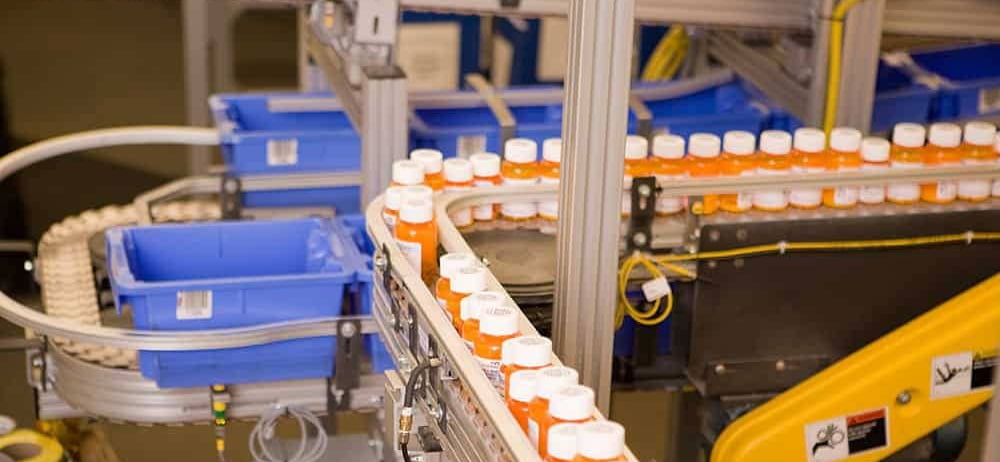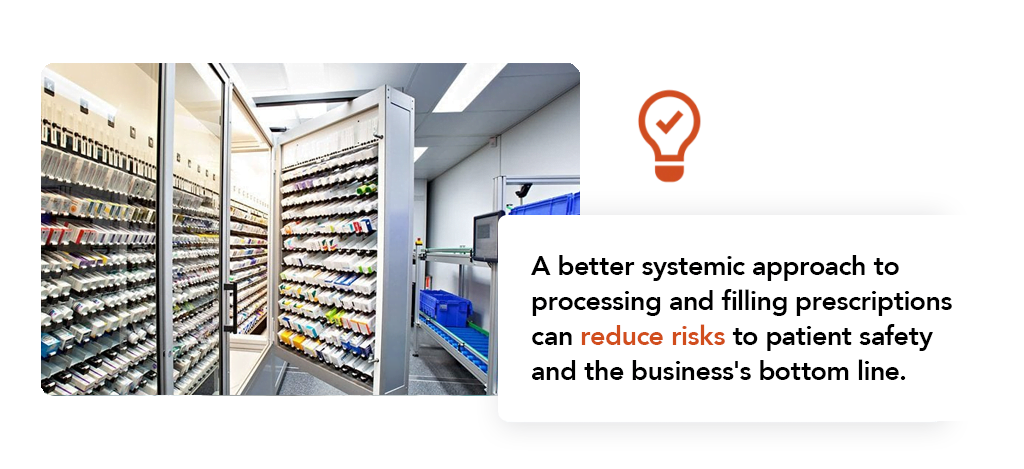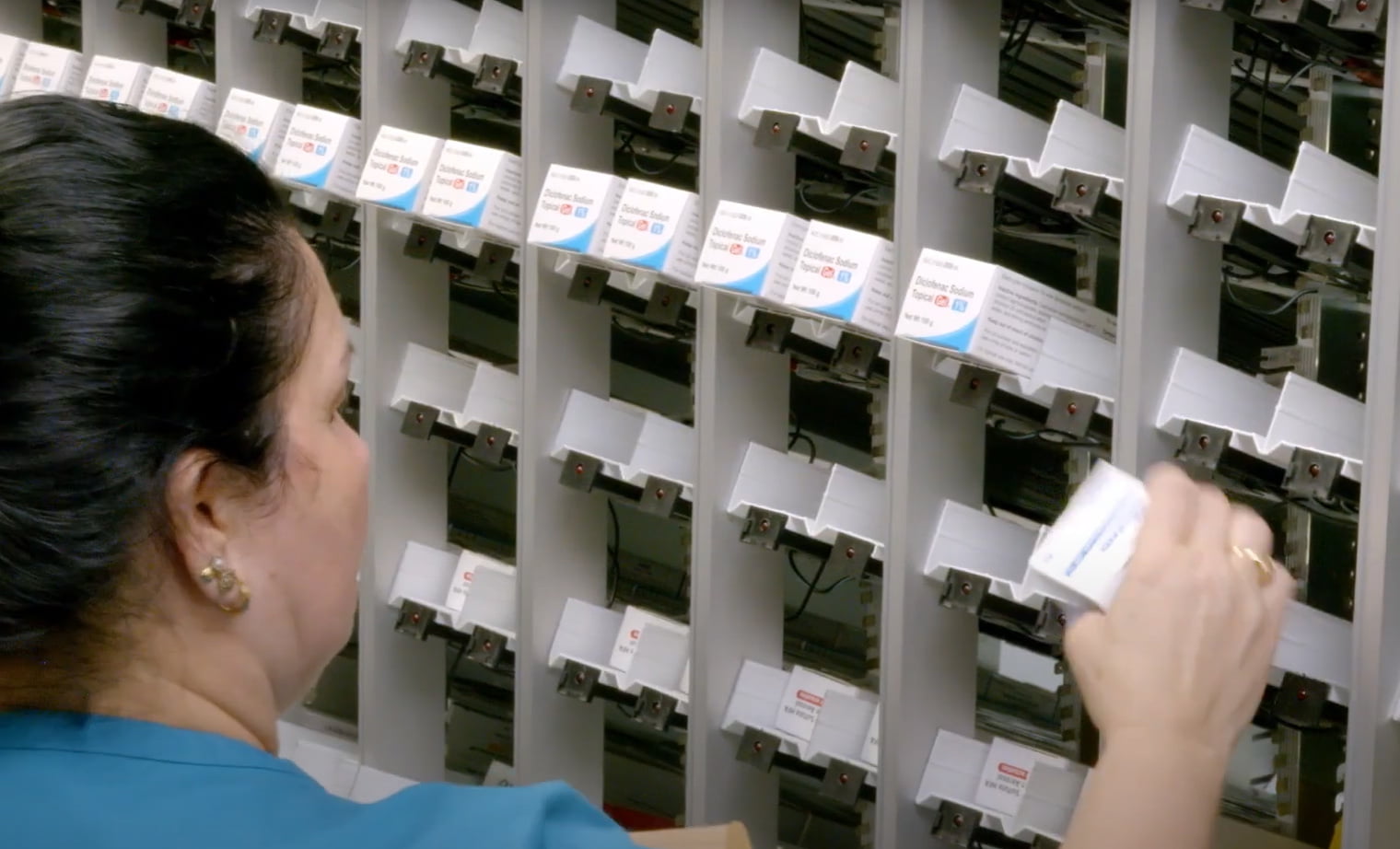
Medication dispensing errors represent a significant risk factor for pharmacies. Industry researchers put the error rate at 1.5% in community pharmacies. The most common medication dispensing errors come from mistakes related to everyday pharmacy tasks, which means there are hundreds of opportunities for errors to occur each shift. Incorrect medication, dosage errors, and faulty directions all contribute to the problem of medication errors.
While manual fills are highly error-prone, central fill automation virtually eliminates dispensing errors, with an error rate of less than one in one million. This level of accuracy mitigates the risk of costly litigation and provides a demonstrated return on investment in the form of increased pharmacy throughput and productivity, better working conditions for pharmacists and technicians, and increased patient satisfaction.
Capsa Healthcare specializes in creating custom central fill pharmacy automation solutions to meet the individual needs of healthcare systems, hub-and-spoke retail pharmacies, and online pharmacy operations, ensuring fast and reliable script filling.
Medication errors are a significant risk in every aspect of healthcare, from the prescriber to the patient. They are costly, counterproductive, and potentially life-threatening, whether they result from a prescribing mistake, a fill error, or a patient compliance issue. National Institutes of Health research identifies medication errors as the most frequent and avoidable source of patient harm. In fact, 7,000 to 9,000 patients die annually as a result of medication errors in the United States.
Whether in retail, an institutional facility, or part of a telehealth or online pharmacy service, pharmacy operations are especially vulnerable to medication errors. Mistakes like dispensing the wrong drug or dosage remain the most common claim in pharmaceutical liability cases, even as error rates decrease, thanks to technological advancements and pharmacy automation.
A study published in the Journal of the American Pharmacists Association compared the 2013 and 2018 data on pharmacist liability claims from the Healthcare Providers Service Organization. The study revealed a decline in claims associated with dispensing an incorrect drug from 43.8% to 36.8% in settled liability cases. Settled wrong dose claims also decreased from 31.5% to 15.3%. However, despite progress toward eliminating these errors, they are still a profound liability for pharmacy organizations.
Research continues to uncover the growing economic impact of medication errors. In general, adverse drug events are widespread and extremely costly. Thirty percent of hospitalized patients are discharged with at least one medication discrepancy, and between 24% and 33% of those errors were deemed preventable. Taking into account the cost of follow-up care and other medical expenses associated with adverse drug events, total costs may be as high as $21 billion annually.
Medication errors in a pharmacy setting also expose the business to legal liability. Liability cases caused by medication errors are expensive to settle. The APhA study cited above found that the average cost of claims in 2013 was $101,269. This figure rose to $136,000 in 2023.
Claim payouts for medication errors resulting in death or significant injury can be substantially higher. Research conducted by a New Jersey-based law firm places the average settlement amount for a medication error case between $150,000 and $300,000. At the same time, a Jury Verdict Research study published by a Maryland attorney found that the median amount for jury-awarded damages in an improper medication lawsuit is $1.2 million.
Beyond the financial ramifications, medication errors contribute to the erosion of trust in healthcare systems and decreased patient satisfaction.
A highly error-prone dispensing process can also lead to increased stress and anxiety for pharmacy personnel. According to a 2019 survey conducted by the Department of Health and Human Services, pharmacy staff members are often under pressure, feeling rushed to complete tasks more quickly than they are comfortable with. Combine that with interruptions and distractions—a common occurrence in a busy retail pharmacy setting—and mistakes are exceedingly likely.
Over time, a vicious cycle develops as overwhelmed pharmacy staff are less able to give patients individualized attention, leading to an increased potential for misunderstandings and mistakes.
Medication errors are hazardous for patients. A 2019 article in the Pharmacy Times recounts the story of a patient who was hospitalized for fluid buildup in her lungs. At discharge, a nurse called in multiple prescriptions to a local chain pharmacy at discharge. The technician who received the prescription call made numerous errors, including misspelling the names of medications. One particularly grave mistake in dosage resulted in the patient’s death.

In another case, a 71-year-old female patient was given the wrong medication for three months. Instead of her prescribed anti-hypertensive medication, amlodipine (brand name Norvasc), the patient received thiothixene (brand name Navane), an antipsychotic drug. The mistake led to multi-symptom physical and psychological harm, including ambulatory dysfunction, tremors, mood swings, and personality changes.
Yet another instance of pharmacy error led to a five-year-old female patient becoming ill after she received an incorrect dosage of an attention-deficit/hyperactivity disorder (ADHD) medication. When the girl’s mother reported the error to the pharmacy, the pharmacist on duty said limited staffing in the busy pharmacy caused her to misread the order as she rushed to fill scripts. The child was taken to the emergency room as a result of her dosage-related illness, and the mother filed a complaint with her state’s pharmacy board.
These stories and countless others illustrate the extreme human cost of medication errors. While human errors can contribute to mistakes that can lead to tragedy, these errors are most frequently the result of inadequate, outdated, or faulty system design. Implementing a better systemic approach to processing and filling prescriptions can mitigate much of the risk to patient safety and the business’s bottom line.
Capsa Healthcare works directly with pharmacy leaders and staff to custom-engineer central fill automation solutions that directly address the challenge of eliminating medication errors in large-scale pharmacy operations. Our engineers create purpose-built solutions that precisely fit the unique requirements of each central fill station.
According to Pablo Arias, Director of Product Line Management for Pharmacy Automation at Capsa Healthcare, “We are innovators who develop specific solutions for central fill, not modified solutions from retail adapted to central fill. Because we design specifically for central fill, the speed, throughput, uptime availability, and accuracy are much higher than any other solution.”
A Capsa-designed solution is more than a combination of off-the-shelf parts assembled with some minor customization. Every solution is a self-contained project designed to grow with our customers as their needs evolve. Arias continues:
“We are probably the only company that can provide our own complete solutions for a central fill, whether it’s dispensing, packaging, automation, software, inventory tracking, or delivery. Because we provide all the solutions, we can also support our customers on any issues that arise. They don’t have to chase multiple vendors to fix a problem.”
Capsa’s tailored automation solutions optimize prescription filling processes for high-volume, high-speed pharmacy operations. Our solution streamlines script filling and eliminates points of failure that occur in a manual fill process. The automated dispensing system can quickly and accurately select the appropriate medication, dose, vial size, and product labels to process 1,000 up to 100,000+ prescriptions per shift efficiently.

In short, our solutions enhance accuracy, speed up service, and simplify data management by integrating intelligent robotics and automated systems with pharmacy management software, ensuring ultimate efficiency and patient safety in central fill pharmacies.
Capsa’s solutions are designed from the ground up for flexibility and scalability. Each install is custom-engineered to suit the particular needs of each client. We consider every aspect of your pharmacy operation as we work with your team to build the right solution for your business. Randy Ward, who owns and operates RxWorkz, an automation consultancy, shares his experience facilitating a collaborative effort between Leon Medical Centers and Capsa Healthcare.
“It’s important to us to always have patient safety first and what’s best for the technicians and labor,” he says. “The great thing about working with Capsa Healthcare … is that they listen to customers better than anyone in my 30 years of experience doing pharmacy automation. They help us make changes that make the product better, not just for them but for the entire industry.”
Ward continues, discussing the importance of both safety and efficiency in pharmacy operations: “The main reason we automated was for safety and efficiency. Our number one consideration when choosing an automation partner was that they could help us grow. We needed to get more volume safely, have an efficient billing method, and do more with fewer bodies because the labor pool is getting tighter in health care.”
Capsa’s solutions are especially adept at addressing the need for safety, efficiency, and scalability. Our innovative, patented technology uses state-of-the-art robotics and intelligent software integrations to process patient scripts, pull and count medication, package and sort orders, and prepare the finalized order for delivery to the patient. Hardware and software work hand-in-hand to ensure seamless prescription and inventory data flow between local pharmacies, central filling sites, sorter cells, labeling stations, packaging centers, and distribution channels.
Our integrated software manages up to 1,200 top unit-of-use medications, covering more than 80% of the daily unit-of-use volume, including cold chain items. This system is capable of dispensing up to three medication packs per second, translating to approximately 480 prescriptions per hour. This high throughput allows the automated solution to efficiently process thousands of prescriptions per shift, enhancing productivity and accuracy.
In addition to managing unit-of-use medications, Capsa’s automation solutions feature High Volume Cells (HVC) specifically designed for central fill environments, with 4,000cc capacity, universal, and self-calibrating cells. These cells are engineered to handle oral solids with high precision and speed, filling a vial every 2-3 seconds on average, and further boosting the efficiency and accuracy of the prescription filling processes, by automating more than 80% of the daily oral-solids volume with just the right number of SKUs in automation. The HVC system’s ability to accurately count and dispense medications ensures that central fill pharmacies can meet high prescription demands while maintaining accuracy and reducing errors.
George Costa, senior vice president of pharmacy operations at Leon Medical Centers, describes how Capsa’s automation solution has enhanced productivity.
“We process 15,000 to 18,000 prescriptions a day very efficiently in a 10-hour period,” he says. “The automation … adds layers of efficiency and quality. The system presents a product to a technician rather than a technician going out to search and pick that product and having the chance of choosing an incorrect product. You also minimize movement. Any steps that you eliminate or decrease saves time and money.”

Implementing automation increased efficiency for Leon Medical Centers and reduced medication errors. While the facility was already operating at an extremely high level of accuracy, Capsa’s solution took it further. “Pre-installation, we only had one or two medication errors from time to time,” Costa says. “We do not see those today—I mean, we’re down to zero errors.”
One of the most exciting things about implementing Capsa’s custom-engineered automation solution is the immediacy of the results. Organizations that implement custom automation see instant gains in productivity, efficiency, and provider satisfaction. “Implement this technology and embrace it. You will get your ROI in less than two years,” Costa says. “I think that’s a good return on investment. You also get your people to do things with their brain instead of doing the manual work.”
Leon Medical Centers pharmacy automation supervisor Pete Gonzalez echoes Costa’s approval. “My technicians now work less, faster, and with fewer mistakes,” he says. “[Before the implementation] there was more pressure on me and all my staff to deliver our medication correctly and more pressure on the pharmacist to check everything better.”
Pharmacy staff are now free from the headaches of heavy manual workloads in a fast-paced, high-pressure environment. That translates to better patient care, a more satisfied pharmacy staff, and increased productivity and profitability.

Just as important, your return on investment isn’t diluted by a heavy maintenance load or frequent downtime. “We’ve had this system for about two years without any let-down on maintenance. It does what it needs to do 24/7,” Gonzalez says. “I’m impressed by how easy it is for me as a maintainer to take it apart. It’s simple, and that’s what I like about it. It’s also easy to replenish because the machine doesn’t stop when I’m replenishing. When you have a shortage of medication, the technician sees it on the screen, and they can replenish it right away. It never fails without inventory.”
Medication errors pose a significant risk for pharmacy operations. As the need for prescription drugs continues to grow and the available workforce shrinks, pharmacy staff will continue to be under intense pressure to perform in a high-stress environment, compounding opportunities for errors to occur.
Adverse drug events cause harm to patients and have cascading negative effects on the business, from depleted morale to costly legal action. The industry benchmark error rate of 1.5% increases the likelihood that your business will experience a medication error and its corresponding consequences. Capsa’s custom-designed automation solutions reduce the error rate from 1.5% to 0.0001% or one in one million. Additionally, our solutions improve throughput, decrease the number of manual tasks pharmacy staff perform, and provide near-100% uptime.
An investment in a custom pharmacy automation solution provides nearly immediate realized returns as error rates instantly decrease and provider satisfaction increases. When you consider these benefits alongside demonstrated improvements in productivity and throughput, it’s clear that every central fill pharmacy business should consider Capsa’s automation solutions.